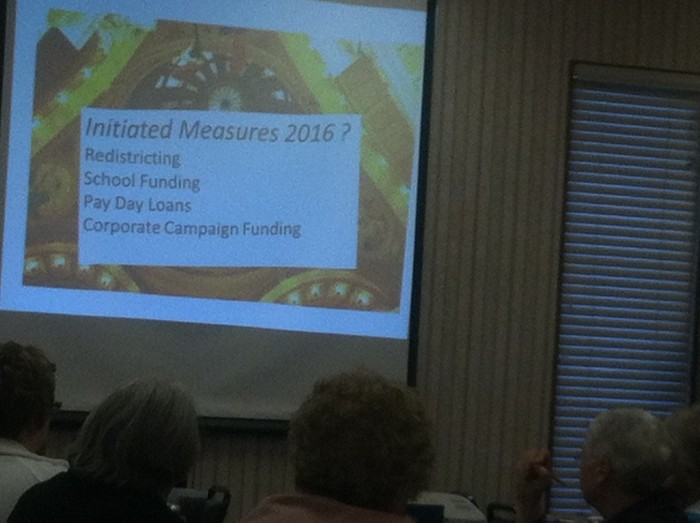Ann Tornberg from the SD Democratic Party did a presentation to Democratic Forum today about the history of the initiative process in SD. She ended the presentation with the above slide of possible initiatives coming up. Representative Bernie Hunhoff is working on the school funding initiative. The redistricting would be changed to having NON-elected, bi-partisan members of the committee.
By l3wis
Related Post
Alex Jensen
Christine Erickson
Count-cilor Alex Jensen
Downtown Sioux Falls
Elections
Erica Beck
Former Mayor
Former Mayor Bucktooth & Bowlcut
Former Mayor Coors Light & Olives
Marshall Selberg
Mayor Almost Done
Mayor Grump Toad
Mayor High Crimes
Mayor Hubris
Mayor Pants on Fire
Mayor Subprime Mike Huether
Mayor TenHaken
Potsdam Mayor
Rich Merkouris
SF City Council
Sioux Falls
Sioux Falls Mayor Race
Who is running for Mayor of Sioux Falls?
5 thoughts on “Possible 2016 Initiatives & Referendums”
Comments are closed.

The redistricting initiative is a definite must – perhaps the first which should be addressed.
Many of the other issues of concern could potentially be rectified through a revitalization of the two party system thanks to a more non-partisan redistricting format.
Beyond the obvious partisan concerns, one of the things which has always bothered me about our current gerrymandering of legislative districts is how Sioux Falls represents 20% of the state population, which means there should be 6 or 7 state senators and 12 or 14 state representatives from Sioux Falls exclusively, but instead I believe we have only four state senators and 8 state house members who are exclusively from Sioux Falls.
Sioux Falls as it is currently dissected by the Republicans for partisan reasons has actually weakened the voice of Sioux Falls in Pierre to the detriment of all Sioux Falls citizens who want a more affective urban voice and the protection of our predominantly singular school district regardless of our citizens political affiliations.
I am not so sure that a non-partisan redistricting committee would look any more favorable towards Sioux Falls, but I have always thought this issue should be used by local Democrats in running for the state legislature, however.
Pay day loan centers are everywhere. I’m in favor of a cap on credit interest. For the loan sharks but also high rate credit cards. When exorbitant profits are curbed, the criminal element will leave the state. Perhaps loan sharks can no longer buy hospitals and (therefore) deprive us from healthcare.
Redistricting won’t change much of anything in terms of partisan representation. There’s virtually nothing being gerrymandered in the first place. If you look at a map of South Dakota legislative districts, most are very compact geographically, and in areas where concentrations of Democratic voters don’t exist for miles and miles. Democrats might gain a couple seats in Sioux Falls, where districts were drawn from the urban core out into the surrounding area, but that’s about it.
No amount of redrawing will get the Democrats anywhere close to a majority.
More Democrats in Pierre means more “reality” for the Republicans in Pierre.
The short term goal of the Democrats should be to end the super majority which the Republicans currently enjoy in both legislative chambers; and a fair redistricting plan would do just that.
As an example, prior to the redistricting, which went into effect for the 1992 election cycle, almost all or all of the legislative districts which included Sioux Falls included only Sioux Falls (except for 11, which at the time was pre-RHS and pre-upper middle income housing demographics and the working-class Democratic vote was stronger then and clearly offset any rural Republican vote at the time).
However, beginning with District 10 in 1992, which grabbed the east side of Sioux Falls and swung around to the south side to grab the Harrisburg region, (and hopefully re-elect a defeated Republican State Senator who had lost in 1990 in a “Sioux Falls” District 14 at the time) the cow was let out of the barn and other legislative districts have followed. Notably, District 12 (from 2002 to 2010) where the Tea area made it increasingly harder to win or to hold onto a legislative seat for the Democrats.
Now the Republican strategy seems to be to use historically rural legislative districts like 9 and 25 to bleed into Sioux Falls, especially at the cost of 15. But then, 15 is allowed to maintain its Democratic dominance by grabbing historically Democratic precincts from legislative districts like 12 and 13 to the latters’ detriments.
Redistricting does matter. It is the first beach front which Democrats need to take hold of, if they are ever going to be relevant again at the state level.
Thanks for the thoughtful response, Winston. I appreciate the historical knowledge you shared; it is interesting how these things unfold.
In the end, I’ll absolutely agree that every seat helps. That said, it does strike me that the SDDP sometimes seems to be tilting at windmills when it comes to the real issues of making the party relevant. They’ve lost a lot of young talent off their bench in recent years. Many of their best candidates seem to be sitting important races out, sensing there’s no good chance for them to succeed. Plus, candidate recruitment is a you-know-what when people think you’re the permanent minority. And South Dakota barely pays its legislators to begin with so it’s an even bigger challenge to get people to go hang out in Pierre for two months and get rolled on every vote.
They can’t afford to wait for the hope that maybe they can get a redistricting initiative passed. They need to figure out how to win on the map they have, not the map they want.